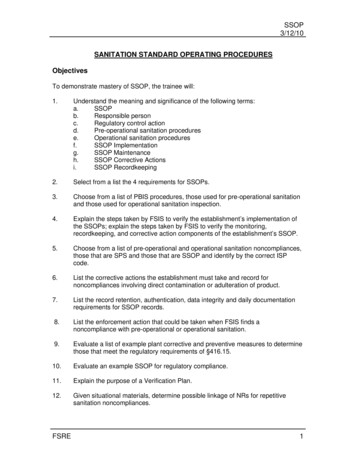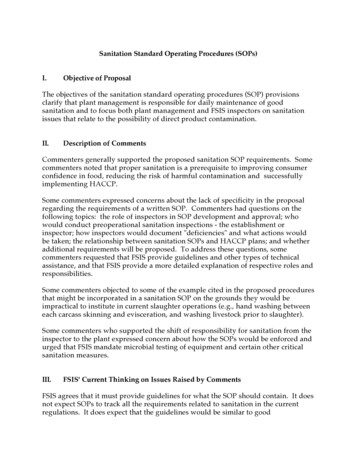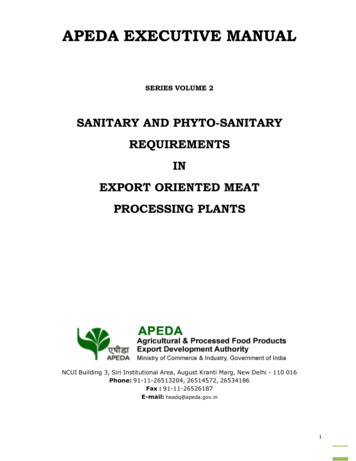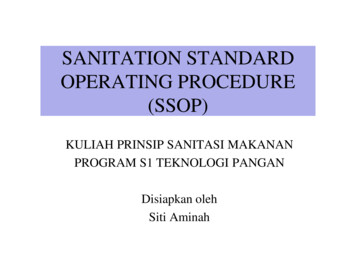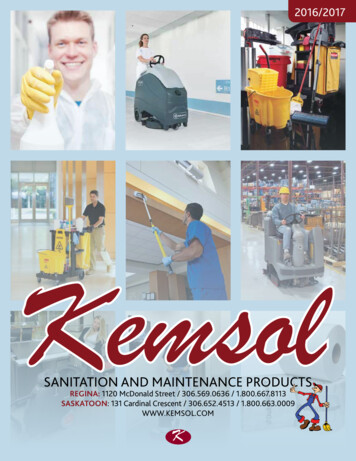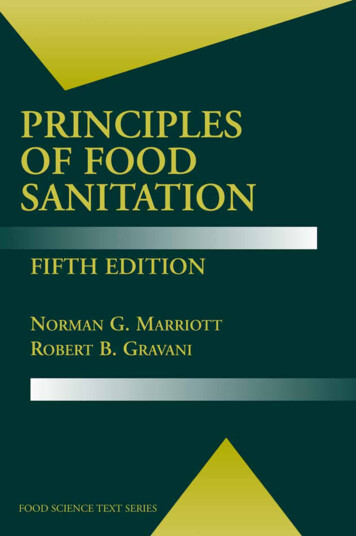
Transcription
Principles of Food SanitationFifth Edition
Principles of Food SanitationFifth EditionNorman G. Marriott, PhDExtension Food Scientist and Professor EmeritusDepartment of Food Science and TechnologyVirginia Polytechnic Institute and State UniversityBlacksburg, Virginia, USAandRobert B. GravaniProfessor of Food ScienceDepartment of Food ScienceCornell UniversityIthaca, New York, USA
Norman G. Marriott, PhDDepartment of Food Science and TechnologyVirginia Polytechnic Institute and State UniversityBlacksburg, Virginia, USAmarriott@vt.eduRobert B. GravaniDepartment of Food ScienceCornell UniversityIthaca, New York, USArbg2@cornell.eduLibrary of Congress Control Number: 2005923527ISBN-10: 0-387-25025-5ISBN-13: 978-0387-25025-0eISBN: 0-387-25085-9Printed on acid-free paper. 2006 Springer Science Business Media, Inc.All rights reserved. This work may not be translated or copied in whole or in part without the written permission of thepublisher (Springer Science Business Media, Inc., 233 Spring Street, New York, New York, 10013, USA), except for briefexcerpts in connection with reviews or scholarly analysis. Use in connection with any form of information storage andretrieval, electronic adaptation, computer software, or by similar or dissimilar methodology now known or hereafter developed is forbidden.The use in this publication of trade names, trademarks, service marks and similar terms, even if they are not identified assuch, is not to be taken as an expression of opinion as to whether or not they are subject to property rights.Printed in the United States of America10 9 8 7 6 5 4 3 2 1springeronline.com
To Dori Marriott, my wife, who has served asan inspiration during the revision of this book andprovided extensive and much-cherished daily love.
Table of ContentsPreface . xiiiChapter 1 Sanitation and the Food Industry .The food industry .What is sanitation?.Why sanitation?.Sanitation laws and regulations and guidelines .Establishment of sanitary practices.Summary.Study questions .11339131415Chapter 2 The Relationship of Biosecurity to Sanitation .Potential risks of foodborne bioterrorism .Bioterrorism protection measures .The role of pest management in biosecurity .Additional bioterrorism information.Summary.Study questions .16171722222324Chapter 3 The Relationship of Microorganisms to Sanitation.How microorganisms relate to food sanitation.What causes microorganisms to grow .Effects of microorganisms on spoilage.Effects of microorganisms on foodborne illness.Foodborne illnesses .Microbial destruction.Microbial growth control .Microbial load determination .Diagnostic tests .Summary.Study questions .252530343536535555626767vii
viiiPRINCIPLES OF FOOD SANITATIONChapter 4 The Relationship of Allergens to Sanitation .What are allergens? .Allergen control .Summary.Study questions .7071717575Chapter 5 Food Contamination Sources .Transfer of contamination .Contamination of foods.Other contamination sources .Protection against contamination .Summary.Study questions .76777780818282Chapter 6 Personal Hygiene and Sanitary Food Handling .Personal hygiene.Sanitary food handling.Summary.Study questions .8383969798Chapter 7 The Role of HACCP in Sanitation.What is HACCP? .HACCP development.Interface with GMPs and SSOPs .HACCP principles .Organization,implementation,and maintenance.Summary.Study questions .9999101106106111114114Chapter 8 Quality Assurance for Sanitation .The role of total quality management.Quality assurence for effective sanitation .Organization for quality assurance .Establishment of a quality assurance program.Summary.Study questions .116117117119125139140Chapter 9 Cleaning Compounds .Soil characteristics .Effects of surface characteristics on soil deposition .Soil attachment characteristics.Cleaning compound characteristics.Classification of cleaning compounds.Cleaning auxiliaries.Scouring compounds.Cleaning compound selection .141141143144146148154156156
Table of ContentsixHandling and storage precautions. 157Summary. 163Study questions . 163Chapter 10 Sanitizers.Sanitizing methods .Summary.Study questions .165165188188Chapter 11 Sanitation Equipment.Sanitation costs .Equipment selection .Cleaning equipment .Sanitizing equipment.Lubrication equipment.Summary.Study questions .190190191193210211211212Chapter 12 Waste Product Handling .Strategy for waste disposal .Planning the survey .Solid waste disposal .Liquid waste disposal .Summary.Study questions .213214214218218233233Chapter 13 Pest Control.Insect infestation .Cockroaches.Insect destruction .Rodents .Birds.Use of pesticides .Integrated pest management .Summary.Study questions .235235235240245249250252255255Chapter 14 Sanitary Design and Construction for Food Processing .Site selection.Site preparation.Building construction considerations .Processing and design considerations .Pest control design .Construction materials .Summary.Study questions .257257258258260265266266266
xPRINCIPLES OF FOOD SANITATIONChapter 15 Low-Moisture Food Manufacturing and Storage Sanitation .Sanitary construction considerations .Receipt and storage of raw materials .Cleaning of low-moisture food manufacturing plants .Summary.Study questions .268268272280281281Chapter 16 Dairy Processing Plant Sanitation .Role of pathogens .Sanitary construction considerations .Soil characteristics in dairy plants.Sanitation principles.Cleaning equipment .Summary.Study questions .283284286287288291296296Chapter 17 Meat and Poultry Plant Sanitation .Role of sanitation.Sanitation principles.Cleaning compounds for meat and poultry plants .Sanitizers for meat and poultry plants .Sanitation practices .Sanitation procedures.Troubleshooting tips.Summary.Study questions .298298306308309312314324325325Chapter 18 Seafood Plant Sanitation .Sanitary construction considerations .Contamination sources.Sanitation principles.Recovery of by-products .Summary.Study questions .327327329330334334334Chapter 19 Fruit and Vegetable Processing Plant Sanitation .Contamination sources.Sanitary construction considerations .Cleaning considerations .Cleaning of processing plants .Cleaners and sanitizers.Cleaning procedures .Evaluation of sanitation effectiveness .Summary.Study questions .336336338340341343344346348348
Table of ContentsxiChapter 20 Beverage Plant Sanitation .Mycology of beverage manufacture .Sanitation principles.Nonalcoholic beverage plant sanitation .Brewery sanitation.Winery sanitation .Distillery sanitation .Summary.Study questions .350350350352355361367369369Chapter 21 Foodservice Sanitation .Sanitary design.Contamination reduction .Sanitary procedures for food preparation.Sanitation principles.Foodservice sanitation requirements .Summary.Study questions .371371374376376389391391Chapter 22 Management and Sanitation .Management requirements .Employee selection .Management of a sanitation operation .Total quality management.Summary.Study questions .392392394396400401401Index . 406
PrefaceIn this era of emphasis on food safety andsecurity, high-volume food processing andpreparation operations have increased theneed for improved sanitary practices fromprocessing to consumption. This trend presents a challenge for the food processing andfood preparation industry.Sanitation is an applied science for theattainment of hygienic conditions. It isreceiving additional attention from those inthe food industry. During the past, inexperienced employees with few skills who havereceived little or no training have been givensanitation tasks. Still, sanitation employeesshould have knowledge about the attainmentof hygienic conditions. In the past, theseemployees, including sanitation programmanagers, have had only limited exposure tothis subject. Technical information has beenlimited primarily to a number of trainingmanuals provided by regulatory agencies,industry and association manuals, and recommendations from equipment and cleaningcompound firms. Most of this material lacksspecific information about the selection ofappropriate cleaning methods, equipment,compounds, and sanitizers for maintaininghygienic conditions in food processing andpreparation facilities.The purpose of this text, as with previouseditions, is to provide sanitation informationneeded to ensure hygienic practices and safefood. Sanitation is a broad subject; thus,principles related to contamination, cleaningcompounds, sanitizers, and cleaning equipment, as well as specific directions for applying these concepts to attain hygienicconditions in food processing or food preparation operations, are discussed.The discussion starts with the importanceof sanitation and also includes informationabout regulations. Increased concerns aboutbiosecurity necessitated the need to addChapter 2, which addresses this subject. Toenable the reader to understand more fullythe fundamentals of food sanitation, Chapter 3 is updated and devoted to microorganisms and their effects on food products.Current information is provided on pathogenic microorganisms and rapid microbialdetermination methods. The ubiquity ofallergens and concern of those affected suggested the need to add Chapter 4 on this subject. A discussion of contamination sourcesand hygiene has been updated (Chapters 5and 6), including how management canencourage improved sanitation. Chapter 7provides updated information on HazardAnalysis Critical Control Points (HACCP).Chapter 8 is about quality assurance (QA)and sanitation. Updated information givenhere presents specific details on how toxiii
xivPRINCIPLES OF FOOD SANITATIONorganize, implement, and monitor an effective program.Chapter 9 discusses cleaning compoundsand contains current information on thissubject. It examines characteristics of soildeposits and identifies the appropriategeneric cleaning compounds for the removalof various soils. Also, it looks at how cleaning compounds function, identifies theirchemical and physical properties, and offersinformation on their appropriate handling.Because of the importance of sanitizing,Chapter 10 discusses updated informationabout sanitizers and their characteristics.Specific generic compounds for variousequipment and areas, as well as updatedinformation on such compounds, are discussed.Chapter 11 provides updated information on cleaning and sanitizing equipmentbest suited for various applications in thefood industry. It provides detailed descriptions, including new illustrations of mostcleaning equipment that may be used infood processing and food preparationfacilities.Current waste product handling, whichremains a major challenge for the foodindustry, is discussed in detail in Chapter 12.This chapter contains updated informationabout the treatment and monitoring of liquid wastes. Pest control is another problemfor the food industry. Chapter 13 providesupdated discussion about common pestsfound in the food industry; their prevention,including chemical poisoning; IntegratedPest Management (IPM) and biological control; and the potential advantages and limitations of each method. New informationabout sanitary design and construction isreviewed in Chapter 14.Because sanitation is so important in lowmoisture food processing, dairy, meat andpoultry, seafood, fruit and vegetable, and beverage plants, a chapter is devoted to each ofthese areas. Chapters 15 through 20 presentupdated information on plant construction,cleaning compounds, sanitizers, and cleaningequipment that applies to those segments ofthe industry. These chapters provide the foodindustry with valuable guidelines for sanitation operations and specific cleaning procedures.Chapter 21 is devoted entirely to currentsanitation information for the foodserviceindustry. It provides instructions on how toclean specific areas and major equipmentfound in a foodservice operation.Effective management practices can promote improved sanitation, a topic addressedin Chapter 22. The intent is not to provide anextensive discussion of management principles, but to suggest how effective management practices can improve sanitation.This book is intended to provide an updatedand concise discussion about sanitation oflow-, intermediate-, and high-moisture foods.It can be used as a text for college students andin continuing education courses about sanitation. It will serve as a reference for food processing courses, industry-sponsored courses,and the food industry itself.Appreciation is expressed to those organizations that provided figures to give furtherinsight to information discussed. Also, Iremember the support of my loving wifeduring the preparation of this revised edition.
CHAPTER 1Sanitation and the Food Industryenough food each year to feed 128 people.Even though the number of farms is decreasing, overall farm production is increasing,indicating more efficient productivity. Thisfood production efficiency has resulted in awide variety of foods being made available toU.S. consumers. Proportionally less is spenton food (approximately 10% of disposableincome) than for most consumers in otherparts of the world. Although the structuresof production agriculture and farming practices have changed dramatically over theyears, the result has been a larger, less expensive, more diverse, and safer food supply.THE FOOD INDUSTRYThe food system is a complex, concentrated, and dynamic chain of activities thatbegins with the production of raw agricultural commodities on farms, orchards, andranches and moves to value-added processedand manufactured products and then toretail food stores and foodservice establishments (restaurants and institutions) wherethey are merchandised, prepared, and sold toconsumers. Each sector of the food system isunique in size, scope, and diversity and hasevolved and adapted to changes in demographics and lifestyles, science and technology, and consumer demands. To more fullycomprehend the role of sanitation and foodsafety in the food industry, it is important tounderstand the uniqueness of each sector ofthe food system.Food Processing and ManufacturingFood and beverage processing facilitiestransform raw agricultural materials intointermediate foodstuffs or edible products.In the United States, there are nearly 29,000food plants owned by 22,000 companies.These plants employ about 1.7 million workers, which is just over 1% of all U.S. employment.In recent years, the food processing industryhas become more consolidated and concentrated through mergers and acquisitions. From1993 to 2002, there were over 5,800 mergersand acquisitions in the food industry. To continue attracting customers and increase sales,profits, and market share, food processors areProduction AgricultureAgriculture is the world’s largest industryand involves more people than all otheroccupations combined. This industry generates one out of six jobs in the United States.The United States produces more food thanany other nation and is the world’s largestexporter of agricultural products. Today,there are about 2 million farms in the UnitedStates and the average farmer produces1
2PRINCIPLES OF FOOD SANITATIONrestructuring and expanding opportunities,reducing costs, and developing new valueadded products. In 2003 there were over14,000 new food products developed in theUnited States. The major focus of this newproduct development was on conveniencefoods and this trend appears to be continuing with food manufacturers appealing toon-the-go consumers.Foodservice (Restaurants and Institutions)There are approximately 878,000 restaurant locations in the United States that provide employment for approximately 12million people (almost 9% of the U.S. workforce). Foodservice outlets account for 84%of prepared food and meals sold in theUnited States. Since the 1980s, the food service industry has experienced steady growth.Several factors, including demographics,organizational issues (labor, outsourcing orcontracting of services, and the professionalattainment of management), culinary trends,and technology, have driven this growth andbrought about many changes in the foodservice industry. The two largest segments ofthe commercial foodservice industry are fullservice and fast food restaurants. Most eating and drinking establishments are smallbusinesses, with approximately 70% havingfewer than 20 employees. The U.S. restaurantindustry will continue to experience aboveaverage growth for the foreseeable future dueto favorable demographic trends. Amongquick-service restaurants, recruiting andretraining employees remains a major challenge. Full-service operators also identifiedrecruiting and retraining employees in theirlist of top five challenges that they will facein the future.Food RetailingIn recent years, the U.S. retail food industry has also experienced unprecedented consolidations and structural changes throughmergers, acquisitions, divestitures, internalgrowth, and new competitors. There are over224,000 food stores in the United States,with grocery stores (including supermarkets,commerce stores, and small grocery stores)accounting for more than 96% of food storesales. The average retail food store stocksbetween 25,000 and 40,000 food items andprovides consumers with a wide variety ofproducts.Food retailers are striving to increasecustomer satisfaction by developing andexpanding prepared and convenience foodsand
security, high-volume food processing and preparation operations have increased the need for improved sanitary practices from processing to consumption. This trend pres-ents a challenge for the food processing and food preparation industry. Sanitation is an applied
